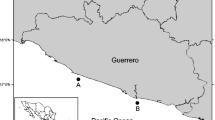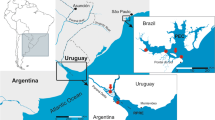Abstract
The concentration of total arsenic and five different arsenic species [As(III), As(V), monomethylarsonic acid (MMA), dimethylarsenic acid (DMA), and arsenobetaine (AsB)], were measured in the muscle, liver and gastrointestinal tract (GIT) of five different fish species [lake whitefish (Coregonus clupeaformis), walleye (Stizostedion vitreum), northern pike (Esox lucius), white sucker (Catostomus commersoni) and longnose sucker (Catostomus catostomus)] from Back Bay, Great Slave Lake, near the city of Yellowknife, NT, Canada. The total concentration (dry weight) of arsenic in muscle ranged from 0.57 to 1.15 mg/kg, in the liver from 0.42 to 2.52 mg/kg and in the GIT from 1.48 to 8.92 mg/kg. Among fish species, C. commersoni had significantly higher total arsenic concentrations in the GIT than S. vitreum, E. lucius and C. clupeaformis, and higher total arsenic concentrations in the liver than C. clupeaformis. The mean concentration of As(III) and As(V) in the muscle of all fish ranged from ≤0.01 to 0.05 mg/kg and ≤0.01 to 0.02 mg/kg, respectively, and together comprised ≤7.5% of the total arsenic measured in muscle. The concentrations of MMA were below detection in the muscle of all five fish species. However, AsB and DMA were measured in all fish species and nearly all fish tissues. The concentrations of AsB ranged from 0.01 to 0.13 mg/kg and the concentrations of DMA ranged from <0.02 to 0.45 mg/kg. The majority (>50%) of organic arsenic in almost all of the tissues from fish caught in Back Bay was not directly identified. Evidence from the literature suggests that most of these other organic arsenic species were likely trimethylated arsenic compounds, however, further analytical work would need to be performed to verify this hypothesis.
Similar content being viewed by others
References
Andrewes, P., Demarini, D. M., Funasaka, K., Wallace, K., Lai, V. W. M., Sun, H., et al. (2004). Do arsenosugars pose a risk to human health? The comparative toxicities of a trivalent and pentavalent arsenosugar. Environmental Science and Technology, 38, 4140–4148.
Bernstam, L., & Nriagu, J. (2000). Molecular aspects of arsenic stress. Journal of Toxicology and Environmental Health Part B, 3, 293–322.
Chen, C. Y., & Folt, C. L. (2000). Bioaccumulation and diminution of arsenic and lead in a freshwater food web. Environmental Science and Technology, 34, 3878–3884.
Clark, I. D., & Raven, K. G. (2004). Sources and circulation of water and arsenic in the Giant Mine, Yellowknife, NWT, Canada. Isotopes in Environmental Health Studies, 40, 115–128.
Cockell, K. A., & Bettger, W. J. (1993). Investigations of the gall bladder pathology associated with dietary exposure to disodium arsenate hepahydrate in juvenile rainbow trout (Oncorhynchus mykiss). Toxicology, 77, 233–248.
Dillon Consulting Limited (2002). Biological Sampling at Baker Creek 2002, Final Technical Report, Prepared for Department of Indian Northern Development. NT, Canada: Yellowknife.
Environment Canada (2002). Metal Mining Guidance Document for Environmental Effects Monitoring. Environmental Effects Monitoring Office, Environmental Conservation Branch, Environment Canada, Ottawa, ON, Canada.
Feldmann, J., Devalla, S., Raab, A., & Hansen, H. R. (2004). Analytical strategies for arsenic speciation in environmental and biological samples. In A. V. Hirner, & H. Emons (Eds.), Organic Metals and Metalloid Species in the Environment (pp. 41–70). New York: Springer.
Jankong, P., Chalhoub, C., Kienzl, N., Goessler, W., Francesconi, K. A., & Visoottiveseth, P. (2007). Arsenic accumulation and speciation in freshwater fish living in arsenic-contaminated waters. Environmental Chemistry, 4, 11–17.
Kaise, T., Ogura, M., Nozake, T., Saithoh, K., Sakurai, T., Matsubara, C., et al. (1997). Biomethylation of arsenic in an arsenic-rich freshwater environment. Applied Organometallic Chemistry, 11, 297–304.
Kapaj, S., Peterson, H., Liber, K., & Bhattacharya, P. (2006). Human health effects from chronic arsenic poisoning–A review. Journal of Environmental Science and Health Part A, 42, 2399–2428.
Kirby, J., & Maher, W. (2002). Tissue accumulation and distribution of arsenic compounds in three marine fish species: Relationship to trophic position. Applied Organometallic Chemistry, 16, 108–115.
Koch, I. (1998). Arsenic and antimony species in the terrestrial environment. BC, Canada: Dissertation. Vancouver: University of British Columbia.
Kuroiwa, T., Ohki, A., Naka, K., & Maeda, S. (1994). Biomethylation and biotransformation of arsenic in a freshwater food chain: Green algae (Chlorella vulgaris)—shrimp (Neocaridina denticulata)—Killifish (Oryzias latipes). Applied Organometallic Chemistry, 8, 325–333.
Le, X. C. (2001). Arsenic speciation in the environment and humans. In W. T. Frankenberger (Ed.), Environmental Chemistry of Arsenic (pp. 95–116). New York: Marcel Dekker.
MacDonald, D. D. (1997). Controlling Arsenic Releases to the Environment in the Northwest Territories—Summary. Prepared for Environmental Protection, Environment Canada, Yellowknife, NT, by MacDonald Environmental Services Ltd., Ladysmith, BC.
Mason, R. P., Laporte, J. M., & Andres, S. (2000). Factors controlling the bioaccumulation of mercury, methylmercury, arsenic, selenium and cadmium by freshwater invertebrates and fish. Archives of Environmental Contamination and Toxicology, 38, 283–297.
McSheehy, S., & Mester, Z. (2004). Arsenic speciation in marine certified reference material. Part 1. Identification of water-soluble arsenic using multi-dimensional liquid chromatography combined with inductively coupled plasma, electrospray and electrospray high field asymmetric waveform ion mobility spectrometry with mass spectrometric detection. Journal of Analytical Atomic Spectrometry, 19, 373–380.
Moore, W. (1989). Influence of water movements and other factors on the distribution and transport of heavy metals in a shallow bay (Canada). Archives of Environmental Contamination and Toxicology, 10, 715–724.
Mudroch, A., Joshi, S. R., Sutherland, D., Mudroch, P., & Dickson, K. M. (1989). Geochemistry of sediments in the Back Bay and Yellowknife Bay of the Great Slave Lake. Environmental Geology and Water Sciences, 14, 35–42.
Pedlar, R. M., & Klaverkamp, J. F. (2002). Accumulation and distribution of dietary arsenic in lake whitefish (Coregonus clupeaformis). Aquatic Toxicology, 57, 153–166.
Pedlar, R. M., Ptashynski, M. D., Evans, R. E., & Klaverkamp, J. F. (2002a). Toxicological effects of dietary arsenic exposure in lake whitefish (Coregonus clupeaformis). Aquatic Toxicology, 57, 167–189.
Pedlar, R. M., Ptashynski, M. D., Wautier, K. G., Evans, R. E., Baron, C. L., & Klaverkamp, J. F. (2002b). The accumulation, distribution, and toxicological effects of dietary arsenic exposure in lake whitefish (Coregonus clupeaformis) and lake trout (Salvenus namaycush). Comparative Biochemistry and Physiology Part C, 131, 73–91.
Scott, W. B., & Crossman, E. J. (1998). Freshwater Fishes of Canada. Oakville: Galt House Publishing.
SigmaStat® Statistical Software Version 2.03. 1997. SPSS Inc., Chicago IL, USA.
Slejkovec, Z., Bajc, Z., & Doganoc, D. Z. (2004). Arsenic speciation patterns in freshwater fish. Talanta, 62, 931–936.
Soeroes, C., Goessler, W., Francesconi, K. A., Kienzl, N., Schaeffer, R., Fodor, P., & Kuenhelt, D. (2005). Arsenic speciation in farmed Hungarian freshwater fish. Journal of Agriculture and Food Chemistry, 53, 9238–9243.
SRK Consulting (2002). Final Report—Arsenic Trioxide Management Alternatives—Giant Mine. Prepared for Department of Indian Affairs and Northern Development by Steffen. Vancouver, BC, Canada: Robertson and Kirsten (Canada) Inc.
Suhendrayatna, A. O., Ohki, T., & Maeda, S. (2001). Biotransformation of arsenite in freshwater food-chain models. AppliedOrganometallic Chemistry, 15, 277–284.
Suhendrayatna, A. O., Ohki, A., Nakajima, T., & Maeda, S. (2002a). Studies on the accumulation and transformation of arsenic in freshwater organisms. II. Accumulation and transformation of arsenic compounds by Tilapia mossambica. Chemosphere, 46, 325–331.
Suhendrayatna, A. O., Ohki, A., Nakajima, T., & Maeda, S. (2002b). Studies on the accumulation and transformation of arsenic in freshwater organisms. I. Accumulation, transformation and toxicity of arsenic compounds to the Japenese medaka, Oryzias latipes. Chemosphere, 46, 319–324.
US EPA (2003). Technical Summary of Information Available on the Bioaccumulation of Arsenic in Aquatic Organisms. EPA-822-R-03-032. Office of Science and Technology, Office of Water, Washington, DC, USA.
Xie, Q., Kerrich, R., Irving, E., Liber, K., & Abou-Shakara, F. (2002). Determination of five arsenic species in aqueous samples by HPLC coupled with a hexapole collision cell ICP-MS. Journal of Analytical and Atomic Spectrometry, 17, 1037–1041.
Zheng, J., & Hintelmann, H. (2004). Hyphenation of high performance liquid chromatography with sector field inductively coupled plasma mass spectrometry for the determination of ultra-trace level anionic and cationic arsenic compounds in freshwater fish. Journal of Analytical and Atomic Spectrometry, 19, 191–195.
Author information
Authors and Affiliations
Corresponding author
Rights and permissions
About this article
Cite this article
de Rosemond, S., Xie, Q. & Liber, K. Arsenic concentration and speciation in five freshwater fish species from Back Bay near Yellowknife, NT, CANADA. Environ Monit Assess 147, 199–210 (2008). https://doi.org/10.1007/s10661-007-0112-6
Received:
Accepted:
Published:
Issue Date:
DOI: https://doi.org/10.1007/s10661-007-0112-6




